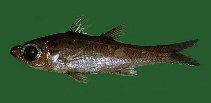| Family: |
Epigonidae (Deepwater cardinalfishes) |
| Max. size: |
19.7 cm SL (male/unsexed) |
| Environment: |
bathydemersal; marine; depth range 160 - 742 m |
| Distribution: |
Eastern Atlantic: western Mediterranean to the African coast except between 11°N and 6°S. |
| Diagnosis: |
Dorsal spines (total): 7-7; Dorsal soft rays (total): 9-9; Anal spines: 2-2; Anal soft rays: 8-9. Gill rakers on first arch have the common styloid shape. Teeth are developed on the center and edges of the tongue (Ref. 31632). Snout tapering to a rounded point; eye very large, longer than high. Opercular spine pungent, bony, surmounted by one or more poorly ossified spinelets. Mouth large, lower jaw equal to or projecting slightly beyond upper jaw. Pyloric caeca 6-8. Preserved specimens are yellow-brown in color; dorsal fin membrane dark. |
| Biology: |
Occurs chiefly on the upper portion of the continental slope. Depth range from 200-600 m (Ref. 07321, 74332) and from 351-742 m in the eastern Ionian Sea (Ref. 56504, 74332). A mesobenthic-pelagic species living mainly above the bottom (Ref. 31632). Adults are strongly associated with the substrate (Ref. 4738). |
| IUCN Red List Status: |
Least Concern (LC); Date assessed: 11 July 2012 Ref. (130435)
|
| Threat to humans: |
harmless |
Source and more info: www.fishbase.org. For personal, classroom, and other internal use only. Not for publication.
